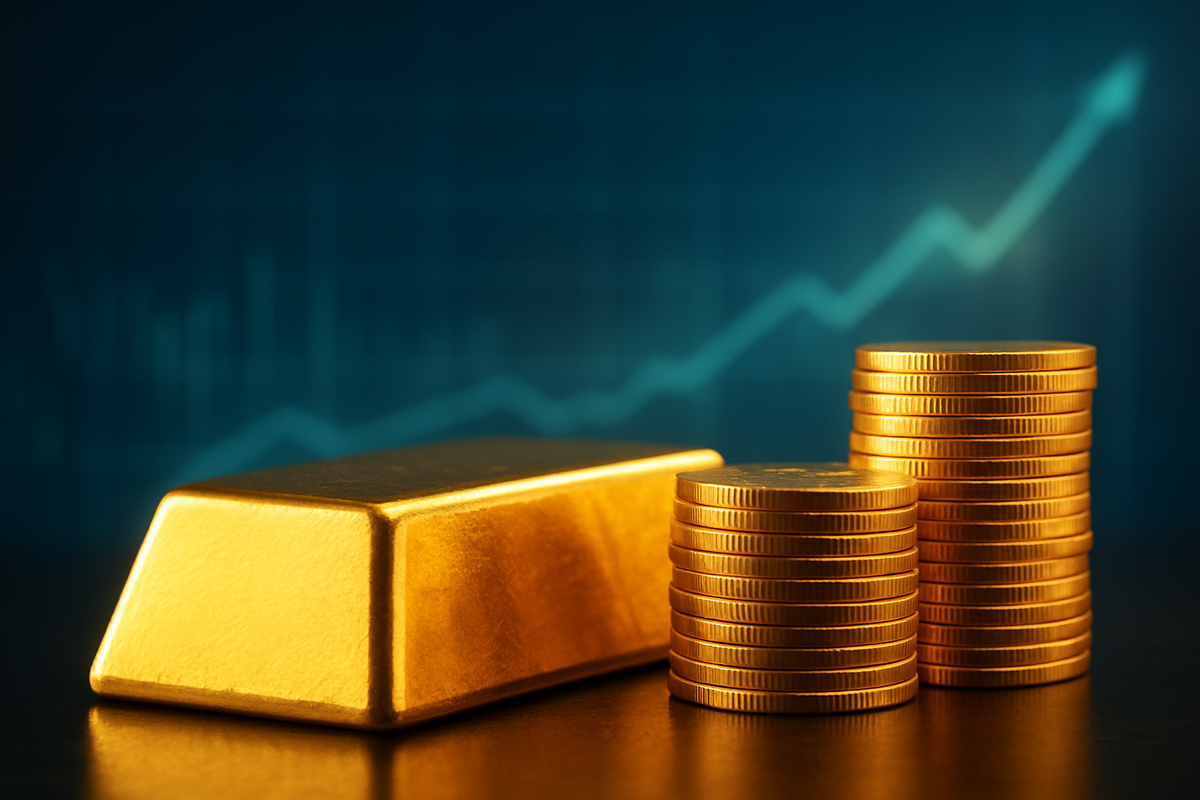
New York, NY – November 28, 2025 – Gold (XAU/USD) has surged dramatically, climbing above the $4,190 mark and posting a robust 2.9% weekly gain, solidifying its position for a fourth consecutive monthly advance and its strongest annual performance since 1979. This significant rally is unfolding against a backdrop of two pivotal events: the swift resolution of a major trading outage at the CME Group (NASDAQ: CME) and overwhelmingly high expectations, now pegged at 89%, for a Federal Reserve interest rate cut in December 2025. The confluence of these factors has ignited a powerful bullish sentiment in the precious metals market, sending a clear signal of shifting economic and monetary landscapes.
The immediate implications for financial markets are profound, with investors flocking to gold as a dual hedge against potential economic deceleration and a beneficiary of looser monetary policy. While the CME outage presented a temporary technical disruption, its rapid containment underscored the underlying strength of demand for safe-haven assets. The prevailing sentiment is that the Federal Reserve (FED) is poised to pivot towards an accommodative stance, further diminishing the opportunity cost of holding non-yielding assets like gold and setting the stage for continued upward momentum in the precious metal's valuation.
Unpacking the Gold Rush: A Timeline of Market Movers
The recent surge in gold prices to above $4,190 per ounce, nearing its all-time high of $4,379.13 reached on October 17, 2025, is a culmination of several critical developments. This week alone, the precious metal has demonstrated remarkable resilience, shrugging off a significant technical disruption to maintain its upward trajectory. The driving force behind this rally is multifaceted, deeply rooted in both technical market events and fundamental shifts in monetary policy expectations.
On Friday, November 28, 2025, the CME Group (NASDAQ: CME), one of the world's largest derivatives exchanges, experienced a prolonged trading halt across a wide array of its markets. A cooling system malfunction at a key data center brought trading in gold, silver, foreign exchange, commodities, Treasuries, and U.S. equity futures to a standstill for over eleven hours. This unforeseen disruption caused temporary liquidity concerns and widened bid-ask spreads, creating momentary uncertainty among traders. However, the exchange successfully resumed trading by 13:35 GMT, mitigating what could have been a more severe market impact. Analysts largely attributed the limited overall directional effect to the traditionally thin trading volumes associated with the post-Thanksgiving "Black Friday" session in the U.S., alongside the continued functionality of over-the-counter spot markets for precious metals.
Simultaneously, and arguably more impactful, are the dramatically escalating expectations for a Federal Reserve interest rate cut in December 2025. Prediction markets and financial indicators now show probabilities exceeding 80%—some even as high as 89%—for a 25-basis-point reduction. This figure represents a sharp increase from just 30-40% a week prior, reflecting a significant dovish shift in market sentiment. The catalysts for this shift include a series of recent dovish remarks from Fed officials, coupled with incoming economic data pointing to a cooling labor market, softer overall economic activity, and weaker-than-expected inflation signals, particularly from the Producer Price Index (PPI). Furthermore, delays in key economic data releases due to a government shutdown have added to market uncertainty, reinforcing bets on a more accommodative monetary policy. The potential appointment of a new Fed chair, Kevin Hassett, reportedly favoring rate cuts, further bolsters these expectations.
The immediate market reaction to these events has been overwhelmingly positive for gold. Investors are increasingly viewing gold as an attractive asset in an environment of anticipated lower interest rates, which reduce the opportunity cost of holding non-yielding assets. The U.S. dollar (USD) has generally weakened against major currencies as rate cut expectations solidify, making gold more affordable for international buyers. Equity markets, despite the CME hiccup, have shown modest gains, with the S&P 500, Dow Jones Industrial Average, and Nasdaq all edging higher. Bond markets are reflecting expectations of lower yields, while other commodities like silver, platinum, and palladium have also seen notable advances. Even cryptocurrencies, such as Bitcoin, have rallied, with its price climbing above $92,000, directly linking its rebound to the fast-moving rate expectations.
Corporate Fortunes: Winners and Losers in a Gold-Backed Market
The current surge in gold prices and the strong probability of a Federal Reserve rate cut are poised to create a distinct landscape of winners and losers across various sectors, significantly impacting public companies trading in the market. Companies directly involved in gold mining and exploration stand to gain substantially, while financial institutions might face mixed fortunes, and other sectors could see indirect effects.
Gold mining companies are the most obvious beneficiaries. Firms like Barrick Gold Corp. (NYSE: GOLD), Newmont Corporation (NYSE: NEM), and Agnico Eagle Mines Ltd. (NYSE: AEM) are likely to see increased revenue and profitability as the price of their primary product rises. Higher gold prices directly translate to fatter margins, assuming production costs remain relatively stable. These companies could leverage increased cash flows for debt reduction, share buybacks, or investments in new exploration projects, potentially boosting their stock valuations. Furthermore, junior mining and exploration companies, often more sensitive to commodity price fluctuations, could attract renewed investor interest and capital for development.
Conversely, some financial institutions, particularly those heavily reliant on interest income, might face headwinds from a Fed rate cut. Banks like JPMorgan Chase & Co. (NYSE: JPM), Bank of America Corp. (NYSE: BAC), and Wells Fargo & Co. (NYSE: WFC) could see their net interest margins (NIM) compress as lending rates decline. While a rate cut might stimulate borrowing and economic activity in the long run, the immediate impact on profitability can be negative. However, investment banks and brokerage firms, especially those with strong precious metals trading desks or asset management divisions focused on commodities, could see increased activity and revenue from the heightened interest in gold and related instruments.
Companies that traditionally struggle in high-interest-rate environments, such as highly leveraged technology firms or those in capital-intensive sectors, might find some relief. Lower borrowing costs could reduce their debt servicing expenses and make new investments more attractive. Retailers and consumer discretionary companies could also benefit from increased consumer spending if lower interest rates stimulate economic growth and improve consumer confidence. However, the primary beneficiaries remain those with direct exposure to gold, either through mining, refining, or investment products. The CME Group (NASDAQ: CME), despite its recent outage, stands to benefit from increased trading volumes in gold futures and options as market activity picks up, reaffirming its role as a key player in the derivatives market.
Broader Implications: Gold's Role in a Shifting Global Economy
The current surge in gold prices and the anticipated Federal Reserve rate cut extend far beyond immediate market reactions, signaling broader shifts in global economic trends, monetary policy, and investor behavior. This event underscores gold's enduring role as a safe-haven asset and an inflation hedge, particularly in times of economic uncertainty and monetary easing.
This rally fits into a broader industry trend where central banks globally have been aggressively accumulating gold, reflecting a diversification away from traditional reserve currencies and a hedge against geopolitical instability. For instance, global central bank gold purchases are projected to exceed 900 tons in 2025, a significant driver of underlying demand. This trend suggests a long-term strategic re-evaluation of reserve assets, positioning gold as a cornerstone of national financial security. Furthermore, robust inflows into gold exchange-traded funds (ETFs) indicate sustained investor interest, mirroring a retail and institutional desire for exposure to the precious metal. The event also highlights the increasing interconnectedness of financial markets, where a technical glitch on a major exchange like CME (NASDAQ: CME) can cause ripples, yet fundamental monetary policy expectations ultimately dictate long-term market direction.
The potential ripple effects on competitors and partners are significant. Other precious metals, such as silver, platinum, and palladium, often track gold's movements, and have already seen substantial gains. This could benefit companies involved in the extraction and processing of these metals. For instance, companies like Hecla Mining Company (NYSE: HL), primarily a silver producer, would likely see an uplift. In the financial sector, asset managers and wealth advisors offering gold-backed investment products or commodity funds could experience increased client interest and asset under management growth. Conversely, traditional fixed-income investments might become less attractive, prompting a re-allocation of capital.
Regulatory and policy implications are paramount, primarily centered around the Federal Reserve's monetary policy. A rate cut would signal a more accommodative stance, potentially aiming to stimulate economic growth and manage inflation. This move could influence other central banks globally, potentially leading to a synchronized easing cycle or creating divergence in monetary policies, impacting currency valuations and international trade flows. Historically, periods of sustained gold rallies have often coincided with phases of monetary expansion or significant geopolitical tensions. For example, gold's performance during the late 1970s and early 2000s, both marked by economic uncertainty and shifting monetary paradigms, offers a historical precedent for its current trajectory. The swift resolution of the CME outage also highlights the critical importance of robust market infrastructure and disaster recovery protocols for maintaining financial stability.
What Comes Next: Navigating Gold's Future Path
The current momentum in gold prices, fueled by the resolution of the CME outage and strong expectations for a Federal Reserve rate cut, sets the stage for a dynamic period in the precious metals market. Both short-term fluctuations and long-term strategic shifts will define gold's trajectory in the coming months and years.
In the short term, gold prices are expected to maintain their bullish bias. Technical analysts are eyeing resistance levels around $4,200-$4,210, with a clear path to retest October's peaks of $4,245. The immediate focus will be on the Federal Reserve's December meeting. A confirmed rate cut, particularly if accompanied by dovish forward guidance, could provide another significant boost to gold, potentially pushing it towards new all-time highs. Conversely, any unexpected hawkish rhetoric or a delay in the rate cut could trigger a temporary pullback. Beyond the Fed, incoming economic data—especially inflation figures and labor market reports—will be crucial in shaping market sentiment and influencing gold's daily movements.
Looking further ahead, the long-term possibilities for gold remain robust. Major financial institutions like JPMorgan Chase & Co. (NYSE: JPM) and Goldman Sachs Group Inc. (NYSE: GS) have already projected gold reaching $5,000 per ounce by late 2026, driven by sustained central bank demand, ongoing geopolitical uncertainties, and a potential prolonged period of lower real interest rates globally. This outlook suggests that gold could transition from merely a safe-haven asset to a more prominent component of diversified investment portfolios. Potential strategic pivots for investors and corporations might involve increasing exposure to gold-backed ETFs, physical gold, or shares of well-managed gold mining companies (e.g., Barrick Gold Corp. (NYSE: GOLD)).
Market opportunities are likely to emerge for investors willing to embrace the volatility inherent in commodity markets. Opportunities could include tactical trading around Fed announcements, long-term accumulation strategies, or investments in companies that provide ancillary services to the gold mining industry. However, challenges will also arise, including potential profit-taking by early investors, unexpected shifts in global economic conditions, or a sudden strengthening of the U.S. dollar due to external factors. Potential scenarios range from a sustained bull run, driven by a dovish Fed and persistent global instability, to periods of consolidation if economic data improves unexpectedly or if the Fed's stance becomes less dovish than anticipated. The outcomes will largely depend on the interplay between monetary policy, geopolitical events, and the broader macroeconomic environment.
Comprehensive Wrap-Up: Gold's Enduring Appeal and Future Outlook
The recent surge in gold prices above $4,190, catalyzed by the swift resolution of the CME Group (NASDAQ: CME) trading outage and overwhelming expectations for a Federal Reserve rate cut, marks a significant moment in the financial markets. This event underscores several key takeaways: gold's inherent resilience as a safe-haven asset, its sensitivity to monetary policy shifts, and its growing appeal in an increasingly complex global economic landscape. The market's ability to quickly absorb a major technical disruption while maintaining its bullish conviction highlights the powerful underlying drivers currently supporting the precious metal.
Moving forward, the market is poised for continued focus on central bank actions, particularly the Federal Reserve's December meeting. A confirmed rate cut would likely reinforce gold's upward trajectory, making it more attractive relative to interest-bearing assets. The U.S. dollar's (USD) performance will also be a critical factor, as a weaker dollar typically enhances gold's affordability for international buyers. Furthermore, persistent geopolitical tensions and the ongoing trend of substantial central bank gold accumulation globally will continue to provide a fundamental floor for prices, suggesting that gold's role as a strategic asset is strengthening.
Investors should closely watch for upcoming economic data releases, especially inflation reports and employment figures, as these will heavily influence the Fed's future policy decisions. Any signs of an economic slowdown or persistent inflation could further bolster gold's appeal. Additionally, monitoring the performance of key gold mining companies like Newmont Corporation (NYSE: NEM) and Barrick Gold Corp. (NYSE: GOLD) will offer insights into the industry's health and profitability. The current environment suggests that gold is not merely reacting to short-term news but is positioned for a potentially prolonged period of strength, driven by a confluence of macroeconomic, monetary, and geopolitical factors.
This content is intended for informational purposes only and is not financial advice






